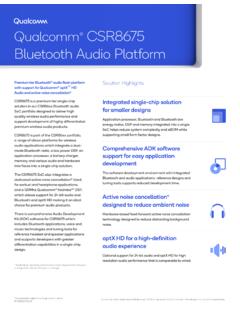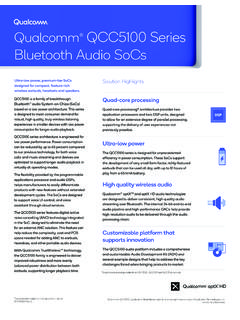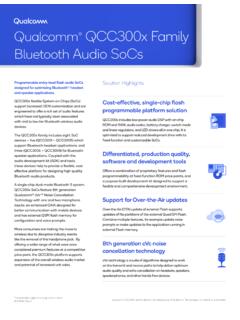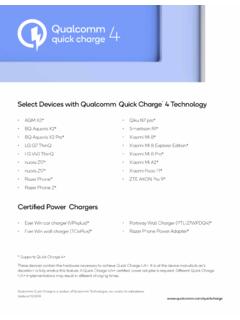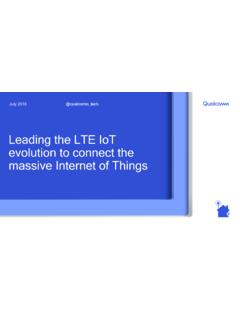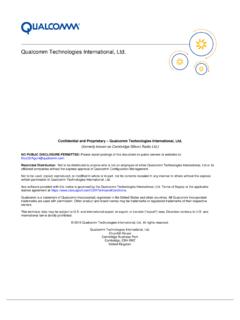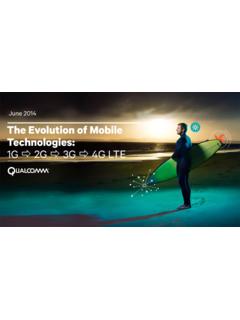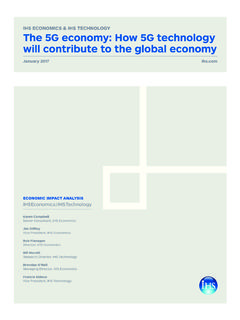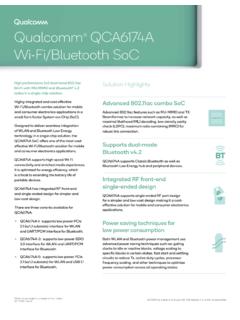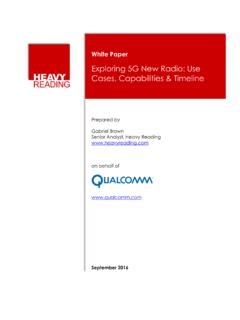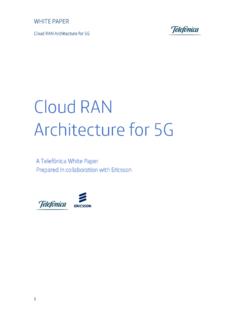Transcription of Mobilizing 5G NR Millimeter Wave: Network …
1 Mobilizing 5G NR Millimeter Wave: Network coverage simulation studies for Global Cities October 2017 qualcomm Technologies, Inc. qualcomm Technologies, Inc. qualcomm and Snapdragon are trademarks of qualcomm Incorporated, registered in the United States and other countries. All qualcomm Incorporated trademarks are used with permission. Other products and brand names may be trademarks or registered trademarks of their respective owners. qualcomm Snapdragon is a product of qualcomm Technologies, Inc. qualcomm Research is a division of qualcomm Technologies, Inc. qualcomm Technologies, Inc. 5775 Morehouse Drive San Diego, CA 92121 2017 qualcomm Technologies, Inc. All Rights Reserved. Table of Contents 1 Executive summary .. 1 2 Mobilizing mmWave with 5G NR technologies.
2 2 3 5G NR mmWave Network coverage simulation studies .. 3 Defining the geographic maps and site locations for the simulation studies .. 3 Establishing a 5G NR mmWave link budget and RF propagation model .. 4 Predicting 5G NR mmWave 5 4 5G NR mmWave Network coverage simulation results .. 5 Significant 5G NR mmWave outdoor coverage with existing LTE sites .. 5 Achieving 95% 5G NR mmWave outdoor coverage with additional sites .. 7 5G NR mmWave can make use of LAA small cell deployments .. 7 Outdoor coverage can be complemented with targeted indoor deployments .. 8 5 Conclusion .. 9 1 1 Executive summary Enhancing mobile broadband services is one of the key initial driving forces behind 5G, fueled by the insatiable demand for faster and better mobile experiences.
3 Mobile networks are facing soaring demands for mobile data as consumers increasingly utilize mobile devices to share and consume high-definition multi-media. In addition, as the capabilities of mobile devices continue to grow with advancements such as higher-resolution cameras, 4K video, always-connected cloud computing, and virtual/augmented reality, so does the ever-increasing demand for faster, better connectivity. A recent study1 showed that mobile data traffic is expected to grow to approximately 50B Gigabytes per month by 2021, representing an impressive growth rate of 47% CAGR from the period of 2016 to 2021. While it is still being extensively tested, the use of high-frequency spectrum bands above 24 GHz, loosely known as Millimeter wave (mmWave), is emerging as a key 5G technology.
4 The use of these bands is very compelling as the large bandwidths (100s of MHz) available at these high frequencies enable extremely high data rates and significant increases in capacity. Historically, mmWave bands were not robust enough for mobile broadband applications due to increased propagation loss and susceptibility to blockage ( hand, head, body, foliage, building penetration). However, advanced antenna techniques that are being introduced with 5G New Radio (NR) the global 5G standard are changing this. 5G NR mmWave mobile deployments will require dense Network topologies with inter-site distances (ISD) of ~150-200 meters. As a result, an additional potential deployment challenge with commercializing 5G NR mmWave is the perceived requirement for many additional small cell sites, which could delay the wide-scale commercial deployments and require large investments.
5 One area of focus for 5G NR mmWave mobile deployments will be high-traffic urban areas in large global cities. To help assess this deployment challenge for 5G NR mmWave, qualcomm Research conducted an extensive set of 5G NR mmWave Network coverage simulation studies in numerous global cities. The objective of this paper is to provide details on the methodology and results from these simulation studies . The results of the simulation studies conducted across ten global cities, show that significant outdoor downlink coverage (up to 81%) is possible when co-siting 5G NR mmWave with existing 4G LTE macro and small cell sites. The positive results show that mobile deployments in urban-areas based on existing LTE cell cities is feasible, especially when considering the tight-interworking of 5G NR with 4G LTE.
6 Although mmWave outdoor-to-indoor coverage for mobile is not feasible, the outdoor mmWave coverage will significantly free up resources in the spectrum bands below 6 GHz for outdoor-to-indoor capacity, utilizing either 4G LTE or 5G NR technology. In addition, outdoor mmWave coverage can be complemented with targeted indoor mmWave deployments. An example coverage simulation for a large indoor venue is also included in the paper. The paper will also provide some background on the key properties for robust 5G NR mmWave operation in a non-line-of-sight (NLOS) mobile environment, as well as showcase how qualcomm Technologies is leading the way to mobilize 5G NR mmWave and make it a commercial reality in 2019. 1 Cisco Visual Networking Index: Global Mobile Data Traffic Forecast (Feb 17) 2 2 Mobilizing mmWave with 5G NR technologies The ever-increasing global demand for enhanced mobile broadband service is driving the need to access more wireless spectrum.
7 Spectrum is the lifeblood of mobile connectivity access to more spectrum increases Network capacity, which means faster data rates and better user experiences. One key opportunity 5G will bring is making use of new higher spectrum bands not previous suitable for mobile communications. 5G NR is being designed not only for bands below 3 GHz where most mobile communications happen today, but also to provide a unified design that will make use of mid-bands, such as to 6 GHz, as well as high-bands above 24 GHz, loosely known as mmWave. Figure 1: Unified 5G NR design across diverse spectrum bands and types Although high-bands above 24 GHz have been utilized for quite some time in carefully engineered fixed, line-of-sight wireless communications for wireless backhaul and satellites, mmWave is a new frontier for mobile.
8 To date, mobile networks were only deployed at scale below 3 GHz because higher frequencies, especially mmWave bands, were not robust enough mobile broadband applications due to increased propagation loss and susceptibility to blockage. Mobilizing mmWave requires a new 5G NR system design, as shown in Figure 2, to overcome these robustness challenges. These advancements are being driven by radical improvements in silicon computation capability, as well as the ability to integrate large numbers of antenna elements and RF chains into cost-effective phased-array RFICs to make mobile device form factors, including smartphones, a possibility. Figure 2: Mobilizing mmWave with advanced 5G NR technologies 3 As implied by the name ( Millimeter wave), the small wavelengths at these higher frequencies makes the use of many antenna elements in a relatively small form factor possible.
9 This characteristic of mmWave will be utilized in the 5G NR mmWave system to make use of massive MIMO antenna arrays to create highly directional beams that focus transmitted RF energy to overcome the propagation and path loss challenges in both the uplink and downlink. These directional beams can also be utilized for spatial reuse. A major lesson learned from the mmWave simulations, channel measurements, and field testing is that it is possible to capture reflected signals in effect, non-line-of-sight (NLOS) signals and use them to supplement the line-of-sight (LOS) signal to increase channel capacity. It is therefore possible to use reflected signals to maintain a link to a mobile device even when it moves entirely out of LOS of the transmitter and this is one reason we can radically expand the role of mmWave for 5G mobile broadband.
10 The 5G NR mmWave system must also adapt quickly to the rapidly changing channel conditions. At mmWave frequencies, even small variations in the environment, such as the turn of the head, movement of the hand, or a passing car, can change the channel and impact performance. The 5G NR mmWave system will employ fast beam steering and switching techniques to discover and switch quickly to the dominant beam path, both within and across access points. As mmWave will deliver more localized indoor/outdoor coverage when compared to spectrum bands below 6 GHz, the 5G NR mmWave system will also require tight integration with sub-6 GHz bands to ensure wide area coverage and a seamless user experience. 5G NR will deliver this tight integration via dual-connectivity where multimode devices simultaneously connect to both sub-6 GHz bands for wide-area coverage and mmWave bands for additional bandwidth and capacity boost.
